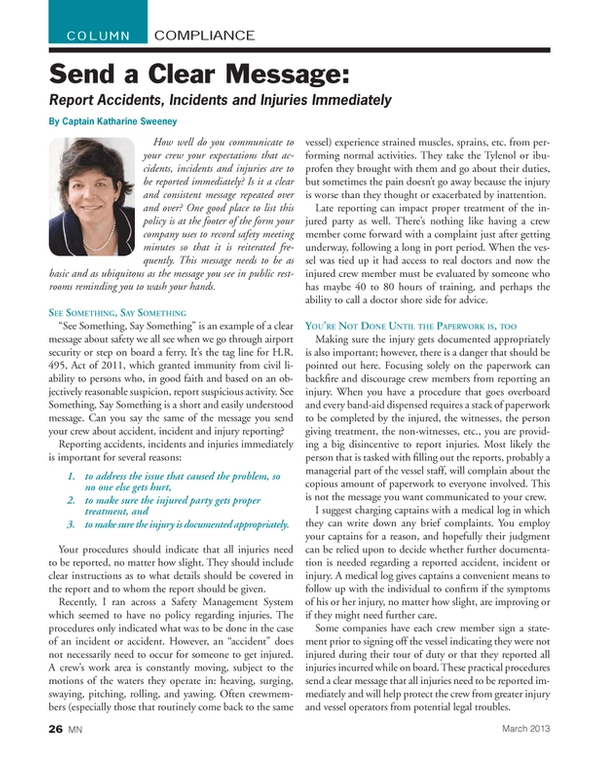
Send a Clear Message: Report Accidents, Incidents and Injuries Immediately
How well do you communicate to your crew your expectations that accidents, incidents and injuries are to be reported immediately? Is it a clear and consistent message repeated over and over? One good place to list this policy is at the footer of the form your company uses to record safety meeting minutes so that it is reiterated frequently. This message needs to be as basic and as ubiquitous as the message you see in public restrooms reminding you to wash your hands.
See Something, Say Something
“See Something, Say Something” is an example of a clear message about safety we all see when we go through airport security or step on board a ferry. It’s the tag line for H.R. 495, Act of 2011, which granted immunity from civil liability to persons who, in good faith and based on an objectively reasonable suspicion, report suspicious activity. See Something, Say Something is a short and easily understood message. Can you say the same of the message you send your crew about accident, incident and injury reporting?
Reporting accidents, incidents and injuries immediately is important for several reasons:
- to address the issue that caused the problem, so no one else gets hurt,
- to make sure the injured party gets proper treatment, and
- to make sure the injury is documented appropriately.
Your procedures should indicate that all injuries need to be reported, no matter how slight. They should include clear instructions as to what details should be covered in the report and to whom the report should be given.
Recently, I ran across a Safety Management System which seemed to have no policy regarding injuries. The procedures only indicated what was to be done in the case of an incident or accident. However, an “accident” does not necessarily need to occur for someone to get injured. A crew’s work area is constantly moving, subject to the motions of the waters they operate in: heaving, surging, swaying, pitching, rolling, and yawing. Often crewmembers (especially those that routinely come back to the same vessel) experience strained muscles, sprains, etc. from performing normal activities. They take the Tylenol or ibuprofen they brought with them and go about their duties, but sometimes the pain doesn’t go away because the injury is worse than they thought or exacerbated by inattention.
Late reporting can impact proper treatment of the injured party as well. There’s nothing like having a crew member come forward with a complaint just after getting underway, following a long in port period. When the vessel was tied up it had access to real doctors and now the injured crew member must be evaluated by someone who has maybe 40 to 80 hours of training, and perhaps the ability to call a doctor shore side for advice.
You’re Not Done Until the Paperwork is, too
Making sure the injury gets documented appropriately is also important; however, there is a danger that should be pointed out here. Focusing solely on the paperwork can backfire and discourage crew members from reporting an injury. When you have a procedure that goes overboard and every band-aid dispensed requires a stack of paperwork to be completed by the injured, the witnesses, the person giving treatment, the non-witnesses, etc., you are providing a big disincentive to report injuries. Most likely the person that is tasked with filling out the reports, probably a managerial part of the vessel staff, will complain about the copious amount of paperwork to everyone involved. This is not the message you want communicated to your crew.
I suggest charging captains with a medical log in which they can write down any brief complaints. You employ your captains for a reason, and hopefully their judgment can be relied upon to decide whether further documentation is needed regarding a reported accident, incident or injury. A medical log gives captains a convenient means to follow up with the individual to confirm if the symptoms of his or her injury, no matter how slight, are improving or if they might need further care.
Some companies have each crew member sign a statement prior to signing off the vessel indicating they were not injured during their tour of duty or that they reported all injuries incurred while on board. These practical procedures send a clear message that all injuries need to be reported immediately and will help protect the crew from greater injury and vessel operators from potential legal troubles.
(As published in the March 2013 edition of Marine News - www.marinelink.com)
Read Send a Clear Message: Report Accidents, Incidents and Injuries Immediately in Pdf, Flash or Html5 edition of March 2013 Marine News
Other stories from March 2013 issue
Content
- FKAB Designs Large Dredger with Nupas-Cadmatic page: 10
- Advances in Bollard Pull Testing Technology page: 14
- Insights: James Hannon USACE Chief, Operations and Regulatory Division page: 18
- Send a Clear Message: Report Accidents, Incidents and Injuries Immediately page: 26
- Three Sheets to the Wind: Three Key Ingredients of the Sober Financial Statement page: 28
- What a Difference a Year Makes page: 32
- To Report or Not to Report - That Should Never be the Question page: 34
- U.S. Shipyards Competing – and Succeeding – Overseas page: 36
- Foss Maritime Expanding Ocean Tug Fleet page: 44
- Bordelon Marine Debuts Stingray Class OSV page: 48
- Proceeding Quietly with Vigor page: 54
- Responding to “The Articulated Tug Barge (ATB) Quandary” page: 60
- Hyde Marine, PG Marine Group and OSV’s: A Perfect Fit page: 66


